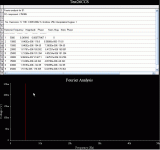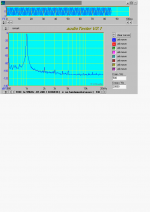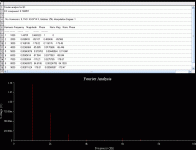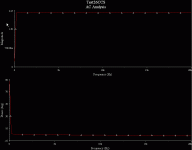boxedin said:How do you measure THD?. Any formulaS?
Yes, found in several basic texts on amplifier design, and indeed google will pop up several dozen instances of the formula if you type in 'THD formula'.
or any method?
There are several methods - easyest one perhaps being nulling out the fundamental (input signal) from the output signal using a bridge (one of the basic electric circuits), and measuring the effective voltage of the residual, or backdriving the output stage with a signal, through the load.
Is it visible in Oscilloscope?
Directly, only if it is gross (>3-5%) and you have a good eye.
If you use the scope to say, look at the residual signal in the correct setup, then of course, yes.
How do you detect it?.
By feeding an amplifier a reasonably 'perfect' sinewave, and looking for harmonics of it's frequency on the output, using various methods.
HINT: look for 'fourier analysis' in your simulator.
Sound from Pure CLASS A without feedback is better than very very low THD Class A with feedback?
If you define 'better' in this context, someone may attempt an answer to that. Also, it is almost impossible to construct a solid state amplifier without some form of feedback. Finally, is class A wit feedback 'impure'?
boxedin said:Sound from Pure CLASS A without feedback is better than very very low THD Class A with feedback?
I will attemp that one, though the answer will not be popular with some.
The statement is not true except for poor designs - but that needs some explanation.
Firstly, there will just about always be audible distortion with any non-feedback circuit that I know of. Point is that the nature of the distortion might create a pleasing effect for some - not all "distortion" (can we rather call it additions by the amplifier?) is objectionable! If you are musical you will realise that 2nd harmonic is everything an octave higher than the original. This could improve some music, and at least will never sound strident. 3rd harmonic is an octave and a 5th higher than the original, a rather "plain" sound, but again not normally strident. It has been reported to "sharpen" the tone of violins. Thus I fear a small amount of these could cause music to sound "more musical" - a description often given.
The ear is very sensitive, but not as perfect as is often thought. It can tolerate copious amounts of the above, and only becomes intolerant to additions from the 5th harmonic up. But then the problem starts: Great annoyance can be experienced with the presence of minute amounts of higher order harmonic distortion, especially odd order - combinations of these can become very strident. It is not consciously heard as an extra but rather generate a feeling of listener fatigue with time, which is the term commonly used for this effect. This is a subject on its own.
This then also explains the subjective experience that some amplifiers sound bland (or whatever term you want to use) with feedback. The fault is usually that an effort was made to "clean up" a mediocre design with too much feedback, which can leave a whole trail of harmonics not showing up in the THD figure but causing listener fatigue. (This is the main reason for the unjust and totally unwarranted condemnation of negative feedback per se.)
This is a very superficial explanation of something more involved, which will hopefully suffice to at least point out the basics.
Regards.
Yes Johan,
If a picture of harmonic structure helps , here is my SKA at around 12.5W. I know it's not Class A but, with 2HD dominant, 3HD some 6 dB lower and higher harmonics 4HD, 5HD at -100 dB is the type of distribution and levels that are quite innocuous.
Cheers,
Greg
If a picture of harmonic structure helps , here is my SKA at around 12.5W. I know it's not Class A but, with 2HD dominant, 3HD some 6 dB lower and higher harmonics 4HD, 5HD at -100 dB is the type of distribution and levels that are quite innocuous.
Cheers,
Greg
Attachments
Just caught this before bedtime.
TO ALL: Yes, that is a pretty representative picture of how matters should be.
It is also, sadly, quite sobering to notice the, often significantly, poorer spectrum analyses given in periodicals of many products described in glorious narrative. As the saying goes: Caveat Emptor!
TO ALL: Yes, that is a pretty representative picture of how matters should be.
It is also, sadly, quite sobering to notice the, often significantly, poorer spectrum analyses given in periodicals of many products described in glorious narrative. As the saying goes: Caveat Emptor!
What I know
about THD, total harmonic distortion,
the limit of what we can hear is a distortion of something like 0.1%.
Fact is that tube power amplifiers sometimes
can have a THD distortion of several %, for example 2.0%,
and still this is acceptable by many listeners.
Car audio amplifiers have used to specify
max power output at 10% THD.
Another fact is that there are very few loudspeakers around
that comes near to or lower than 0.1% distortion at normal output level.
Even high class woofers can have 0.5-1.0% distortion.
Budget class woofers will have even more distortion.
My opinion is that to have power amplifier
with lower dist than 0.05% is of very little practical value.
After sound has passed loudspeakers, including crossover filter,
and waves have passed across your room and furniture
it will never have such low distortion.
When people show simulations with like 0.001% or lower
and even say they have amplifiers with such figures
it may be true,
but to me it is more to put on a show for the other guys.
And these values are surely always before loudspeaker system.
The real world and our ears will never experience
anything like those figures.
Sensible and wise audio designers take this in account
when making amplifiers.
And they dont put too much work into go chasing for fantasy figures.
about THD, total harmonic distortion,
the limit of what we can hear is a distortion of something like 0.1%.
Fact is that tube power amplifiers sometimes
can have a THD distortion of several %, for example 2.0%,
and still this is acceptable by many listeners.
Car audio amplifiers have used to specify
max power output at 10% THD.
Another fact is that there are very few loudspeakers around
that comes near to or lower than 0.1% distortion at normal output level.
Even high class woofers can have 0.5-1.0% distortion.
Budget class woofers will have even more distortion.
My opinion is that to have power amplifier
with lower dist than 0.05% is of very little practical value.
After sound has passed loudspeakers, including crossover filter,
and waves have passed across your room and furniture
it will never have such low distortion.
When people show simulations with like 0.001% or lower
and even say they have amplifiers with such figures
it may be true,
but to me it is more to put on a show for the other guys.
And these values are surely always before loudspeaker system.
The real world and our ears will never experience
anything like those figures.
Sensible and wise audio designers take this in account
when making amplifiers.
And they dont put too much work into go chasing for fantasy figures.
Hi Boxedin,
congratulations, you've got a sym to produce numbers and a pair of plots. Well done. More than I have ever achieved.
Can you redo the last pair of plots with the frequency on a log scale from 1Hz to 100kHz?
and if possible the voltage also on a log scale giving a log log plot.
Then the picture will be more familiar to my inexperienced eyes.
congratulations, you've got a sym to produce numbers and a pair of plots. Well done. More than I have ever achieved.
Can you redo the last pair of plots with the frequency on a log scale from 1Hz to 100kHz?
and if possible the voltage also on a log scale giving a log log plot.
Then the picture will be more familiar to my inexperienced eyes.
lineup said:My opinion is that to have power amplifier
with lower dist than 0.05% is of very little practical value.
...
When people show simulations with like 0.001% or lower
and even say they have amplifiers with such figures
it may be true, but to me it is more to put on a show for the other guys
...
Sensible and wise audio designers take this in account
when making amplifiers. And they dont put too much work into go chasing for fantasy figures.
The THD figure is a sorely inadequate measure for forming this kind of an opinion. THD is a geometric mean of a (ideally) infinite number of harmonically related signals that were not present in the input. Their spread with amplitude and frequency behaves completely differently in tubes, BJTs, FETs, not to mention loudspeakers and amplifiers, especially tube and SS amplifiers (with few exceptions). It is widely accepted that THD is not the whole story, indeed is a very small part of the whole story, so it seems you have formed your opinion of the whole story by reading just one page.
The very low distortion figures on some aplifiers are not a cause for the design, but a consequence, so to say. Because of the way the harmonics making up the THD figures spread, and not all are equally objectionable (in fact, the differences are quite drastic, yet THD calculation treats them all the same), and the way THD rises with frequency in most SS amps, the very low midband (typically 1kHz) THD is a consequence of trying to keep it low enough at the higher frequencies. Some data suggests that amplifiers producing HD mostly above and including the fifth harmonic, need to exhibit THD figures tens to even hundreds of times lower than amplifiers producing HD in harmonics below and including 4th, to be equally listenable.
In particular high NFB factor amplifiers tend to exhibit rises in the amount of high order harmonics. Direct coupled SS amplifiers are the usual culprits simply because you CAN have a very high NFB factor with them - with tubes, this is VERY rarely so. This has lead many who apparently do not understand the concept of declaring NFB as 'bad' (and to some extent, lead people to believe tube amps are 'immune' to this problem), when in reality, it is the amplifier BEFORE the NFB was applied that is at fault, not the NFB as such.
The reasons are twofold:
First of all the amplifier without NFB generates a lot of THD as such (low THD and confinement of it into low harmonics means there is less or ideally nothing for the NFB to reduce in the first place).
Secondly, the amplifiers gain falls with frequency early and or quickly, well within the audio band.
NFB can only reduce distortion as much as the gain difference between no NFB and NFB applied at any given frequency. This figure is often called 'excess gain'. High harmonics obviously tend to fall in the high end of the audible spectrum. If excess gain is considerably lowered at those frequencies, these will be less lowered by NFB, sometimes the effect will be negligible. As a result, the true 'bad design' nature of such an amp gets revealed where you can hear it, but it will produce stellar numbers using standard brochure measurements.
The world becomes a bit nicier place when you have every harmonic in forward path <0.5%. Than the rising of harmonic amplitude with order simply does not exist, because product of intermodulation between harmonics is definitely below any resonable level.
Lowering feedback factor with frequency is completely different issue, also avoidable with linear enough forward path.
Lowering feedback factor with frequency is completely different issue, also avoidable with linear enough forward path.
boxedin said:Ac analysis
Greetings from Norfolk
We have had a number of posts from boxedin, together with a number of simulation results, but he has not said what software he is using.
Further, if the plot that accompanied the quote is based upon points indicated (triangles on plot) then the simulation has, to my mind, missed the points where harmonic distortion will be indicated, i.e. multiples of the fundamental.
Also, as the levels of the harmonics should be low, a linear plot of on the 'Y' axis is very un-informative. This needs to be a log plot, preferably over at least 3 decades (60 dB).
Happy New Year
Richard
Boxedin,
As I read the figures in the table you gave, I find 48% 2nd harmonic, 11% 3rd; 0.4% 5th and 2,7% 7th harmonics. I am sure this is wrong - how do you get 48% 2nd harmonic distortion? If so, WAY too high, but I leave room for error in interpretation on my side. Read on...
Lineup,
You are correct as to magnitude, but loudspeaker distortion is very different from amplifier distortion; mercifully more benign, depending on the make. The contents of my post #45 has been verified in practice. Peter Walker of UK was one of the leaders in this investigation after his initial Quad transistor amplifier caused listener fatigue while others did not, though its THD was way lower. There have also been authoritative tests from Scandinavian leaders. (All these were blind tests i.e. subjects were unaware of what they were listening too.)
As said earlier any complete elucidation would use too much space here, and I am regrettably unable to give internet sources at this time. (My reading and articles hail from before IT time!) A.o. those investigations revealed that certain combinations of higher order harmonics, especially 7 - 11, could cause listener fatigue even when the products lay on or below the threshold of (conscious) audibility. I can't recall exact details, but if it sounds a bit tall, one must remember that medical research has shown that the ear/brain faculty can interpret sound even though it is inaudible in the conscious sense. Simple example is that a dog whistle can cause a headache with some persons though it is way above 20 KHz. (I myself experienced that.)
To perhaps go just the 1st step into this, if one can imagine "stopping the clock" at some moment into e.g. a full orchestral piece, and "measure" all the tones present at that moment (including the harmonics of each musical instrument), it is not difficult to imagine that there could be many hundreds of samples. Should one further calculate say just 5th, 7th, 9th harmonics of ALL these samples (this represents amplifier generated distortion) then it becomes probable that thousands of samples would exist, with the possibility of an even higher quantity of strident combinations. This scene changes from moment to moment, so a practical quantative analysis is just about out of the question. The best solution is to eliminate the existance of higher order harmonic generation to at least below the noise figure.
To repeat, once again a very inadequate exposition - hopefully a general picture would emerge at least.
As I read the figures in the table you gave, I find 48% 2nd harmonic, 11% 3rd; 0.4% 5th and 2,7% 7th harmonics. I am sure this is wrong - how do you get 48% 2nd harmonic distortion? If so, WAY too high, but I leave room for error in interpretation on my side. Read on...
Lineup,
You are correct as to magnitude, but loudspeaker distortion is very different from amplifier distortion; mercifully more benign, depending on the make. The contents of my post #45 has been verified in practice. Peter Walker of UK was one of the leaders in this investigation after his initial Quad transistor amplifier caused listener fatigue while others did not, though its THD was way lower. There have also been authoritative tests from Scandinavian leaders. (All these were blind tests i.e. subjects were unaware of what they were listening too.)
As said earlier any complete elucidation would use too much space here, and I am regrettably unable to give internet sources at this time. (My reading and articles hail from before IT time!) A.o. those investigations revealed that certain combinations of higher order harmonics, especially 7 - 11, could cause listener fatigue even when the products lay on or below the threshold of (conscious) audibility. I can't recall exact details, but if it sounds a bit tall, one must remember that medical research has shown that the ear/brain faculty can interpret sound even though it is inaudible in the conscious sense. Simple example is that a dog whistle can cause a headache with some persons though it is way above 20 KHz. (I myself experienced that.)
To perhaps go just the 1st step into this, if one can imagine "stopping the clock" at some moment into e.g. a full orchestral piece, and "measure" all the tones present at that moment (including the harmonics of each musical instrument), it is not difficult to imagine that there could be many hundreds of samples. Should one further calculate say just 5th, 7th, 9th harmonics of ALL these samples (this represents amplifier generated distortion) then it becomes probable that thousands of samples would exist, with the possibility of an even higher quantity of strident combinations. This scene changes from moment to moment, so a practical quantative analysis is just about out of the question. The best solution is to eliminate the existance of higher order harmonic generation to at least below the noise figure.
To repeat, once again a very inadequate exposition - hopefully a general picture would emerge at least.
darkfenriz said:T...product of intermodulation between harmonics
Well spotted, I did not mention that, thinking it would be a bit too elaborative. I recall participating in another distortion and NFB thread where this was mentioned.
Intermodulation products of harmonics are by definition harmonically related to the fundamental frequency. What is not immediately obvious, is that each pass through another stage generates intermodulation products of the harmonic products of the previous stage, altering the total harmonic spread. For instance, if the first stage produces only 2nd and 3rd harmonic, the next stage will also intermodulate them creating a 5th harmonic where there was previously none - along with harmonics of the previous stages 2nd and 3rd harmonic inputs. Taking the second stage the same as the first, generating only 2nd and 3rd harmonics, we get a 4th, 6th and 9th harmonic of the fundamental signal after the second stage. Intermodulation between harmonics also can result in components generated at the fundamental frequency, which effectively alter the relative amplitude of all harmonics together with respect to the fundamental. Increasing the number of stages obviosuly makes things more complex and generates further high order harmonics (but of course there is no blanket statement as to how much - this depends on many variables).
Fortunately, both harmonic and intermodulation distortion are inter-related, and usually on the same order of magnitude, so harmonic generation is not a snowball effect (unless the stages distort grossly), and this is why keeping stages linear to below 1% pretty much guarantees that things will not get terribly out of hand.
Johan Potgieter said:Boxedin,
As I read the figures in the table you gave, I find 48% 2nd harmonic, 11% 3rd; 0.4% 5th and 2,7% 7th harmonics. I am sure this is wrong - how do you get 48% 2nd harmonic distortion?
Class A full wave rectifier?
Ilimzn,
Now there is a profound thought....
All,
As is sometimes the case several of us seem have posted at the same time. Other posts (all very true) conveniently complemented mine, and should show members less informed on this matter that the complete appreciation of the distortion phenomenon is not simple. It should at least be clear now why THD, though convenient to measure, is currently a very poor indicator of the "acceptability" of an amplifier. In fact, it has just about promotional vaue only.
Now there is a profound thought....
All,
As is sometimes the case several of us seem have posted at the same time. Other posts (all very true) conveniently complemented mine, and should show members less informed on this matter that the complete appreciation of the distortion phenomenon is not simple. It should at least be clear now why THD, though convenient to measure, is currently a very poor indicator of the "acceptability" of an amplifier. In fact, it has just about promotional vaue only.
- Status
- This old topic is closed. If you want to reopen this topic, contact a moderator using the "Report Post" button.
- Home
- Amplifiers
- Solid State
- Another question about class A.



